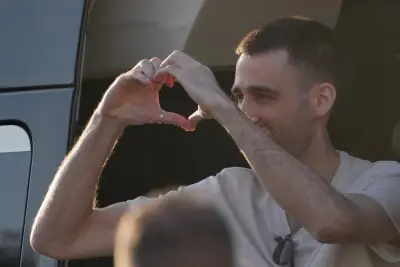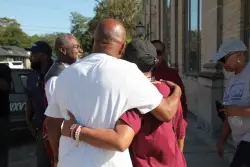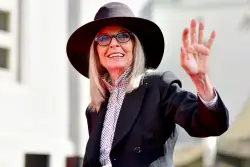Tears of joy as living hostages are returned

LAVON, Israel — It was a day of joy and tears across Israel. Families, loved ones and friends watched as Hamas released the last living hostages held captive for over two years in the Gaza Strip. On day 738 since Alon Ohel was taken hostage, family and friends of the young music lover jumped to their feet, cheered, blew into shofars — traditional horns that announce glad tidings — and hugged each other when they saw his picture on a livestream among the seven hostages Hamas first released to the Red Cross on Monday morning. “This is the best morning in my life. I just want to hug him,” Ohel’s cousin, Noam Rozen, 24, said before choking up. By midday, 13 more hostages were freed, bringing the final number of the living hostages released to 20. With other members of his family, and dozens of supporters cheering, Rozen took down one of the hostage posters that had long been hanging by the village’s entrance and replaced it with a banner saying in Hebrew: “Welcome back home — the heart returned to beating and now we can breathe.” The wait on a Galilee hilltop village Hundreds had been packing the small community center of the hilltop village of Lavon in the Galilee since before dawn for one of the most important days of their lives — when the last 20 living hostages were scheduled to be released, first to the Red Cross and then to the Israeli military, as part of a ceasefire in the Israel-Hamas war. “I told God many months ago, ‘If Alon is coming home, I bring shofar and I say thank you for this,'” said Yaniv Shema Zion, who’s known Ohel since he was a toddler. Wearing T-shirts emblazoned with pictures of Ohel, people from Lavon waved flags, sang hymns, hugged and wiped away tears before falling silent in front of the projected screen carrying images from Gaza of the release. “Knowing Alon, there was no chance not to get him back with us,” his aunt, Nirit Ohel said, though she added the family was still worried about his health. Alon Ohel had had shrapnel in his eye from the Oct. 7, 2023 attack on the bomb shelter in southern Israel where he had sought refuge. People in Lavon jumped on chairs and shouted with joy when the first images of Ohel were broadcast, showing him thin but smiling. People in Tel Aviv’s Hostages Square sobbed as photos of the hostages reuniting with their families flashed on the large screens. The names and faces of the hostages and their families have become household names across Israel over the past two years. Endless days in chains Ohel was kidnapped at the Nova music festival from a mobile bomb shelter along with Hersh Goldberg-Polin, an American-Israeli who was killed in captivity in August 2024. Eli Sharabi, another hostage held with Ohel and released in a previous ceasefire said they were kept chained, with only a moldy pita bread per day for food. Ohel became a symbol of the hostage crisis because of his piano playing. At his mother initiative, pianos in his honor appeared across the country, including next to Jerusalem’s city hall and in Tel Aviv’s square devoted to the hostages. “She wanted people to play and through it, to send their love to him,” Nirit Ohel said. Another of Ohel’s aunts, Einat Rozen, said she was finally able to feel joy again, and praised the community’s support. “Our community was with us all the time,” she said, tears streaming down her face. The hostages’ plight The fate of the 251 hostages taken by Hamas-led militants in the attack on southern Israel just over two years ago, has weighed on every aspect of daily life in this country. Hostage posters and stickers are plastered everywhere — from seaside promenades to countryside bus stops — and many Israelis have been wearing yellow ribbons on their lapels, their wrists, their cars and their gardens for more than two years. For observant Jews, Monday held an extra special meaning. Both the Oct. 7, 2023, attack and the release of hostages overlapped with the Jewish people’s celebration of the holiday of Simchat Torah, which marks the beginning of a new annual cycle of the reading of the scrolls. It is one of the most joyous days of the Jewish calendar, with festive dancing around a Torah. The war began when Hamas-led militants stormed into Israel on Oct. 7, 2023, killing some 1,200 people and taking 251 as hostages. In Israel’s ensuing offensive, more than 67,600 Palestinians have been killed in Gaza, according to Gaza’s Health Ministry, which doesn’t differentiate between civilians and combatants but says around half the deaths were women and children. The ministry is part of the Hamas-run government, and the U.N. and many independent experts consider its figures to be the most reliable estimate of wartime casualties. People react as they watch a live broadcast of Israeli hostages released from Gaza at a plaza known as hostages square in Tel Aviv, Israel on Monday. (AP Photo/Oded Balilty) Freed Israeli hostage Eitan Mor gestures from a van as he arrives at Beilinson hospital in Petah Tikva, Israel, after he was released from Hamas captivity in the Gaza Strip on Monday. (AP Photo/Ariel Schalit) Rom Breslavski, an Israeli hostage released from the Gaza Strip waves from a minibus at the Sheba Medical Center in Ramat Gan, Israel, on Monday. (AP Photo/Leo Correa)

